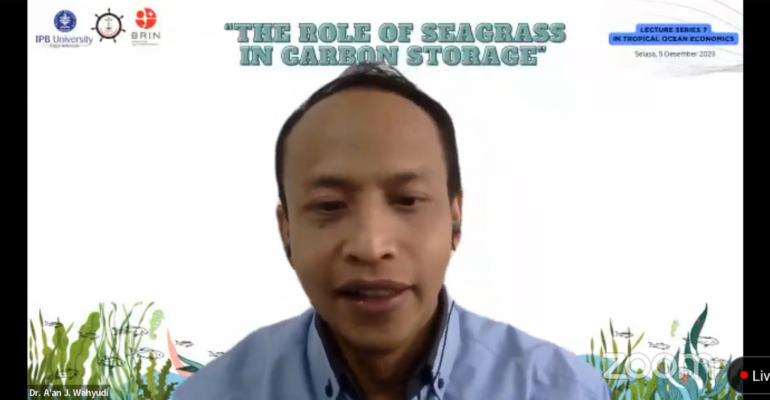Department of ESL IPB University Invites BRIN Researchers to Discuss the Role of Seagrass Meadows as Carbon Stock

The Tropical Marine Economics Study Programme, Department of Resource and Environmental Economics (ESL), Faculty of Economics and Management (FEM) IPB University again held the 7th Lecture Series routine study with the main theme ‘The Role of Seagrass in Carbon Storage’, Tuesday (5/12) online.
This routine activity is intended for students and the public as an enrichment related to the science of tropical economics. The Lecture Series this time also invited Dr A’an Johan Wahyudi, Principal Researcher of the Oceanographic Research Centre of the National Research and Innovation Agency (BRIN) as one of the speakers.
Dr Adi Hadianto, Chairman of the ESL Department at IPB University, said that the potential for large seagrass carbon stocks still needs to be explored. This potential is expected to be one of the commodities that can be included in the carbon stock trading list. In addition to improving the welfare of the community due to the large ecosystem services for marine biota and the marine ecosystem as a whole.
“The issue of carbon stocks still needs to be discussed as an effort to mitigate climate change, so this study is very relevant and in line with the FOLU Net Sink agenda,” said Dr Adi in his speech.
Based on the results of Dr A’an and his team’s research in 2020, it was revealed that the potential of seagrass ecosystems was 875,967 hectares. This total area is estimated to be still larger and could be a great potential as a nature-based climate solution.
However, according to him, further research related to carbon biogeochemistry in seagrass ecosystems still needs to be explored. Especially research on carbon flow and carbon emission factors whose data is still not widely available.
“To fulfil partner requests related to Indonesia’s commitment in the Nationally Determined Contribution (NDC), we still need comprehensive data on carbon emission factors and seagrass inventory, not just the size of carbon stocks. This research should be directed to obtain this information,” he explained.
The potential of seagrass conservation in marine protected areas in five provinces in Indonesia also has great potential to reduce carbon emissions by up to 6.8 per cent compared to business as usual (BAU) emissions or estimated emission levels. The total carbon reduction in 2030 is estimated to reach 11.6 tonnes of CO2.
“Seagrass conservation projects are needed to obtain verified blue carbon credits to fulfil the demand for carbon credits from the private sector,” he added.
The second speaker, Dr Yudi Wahyudi, Dean of the Faculty of Agriculture, Djuanda University, Bogor, also said that the potential of seagrass ecosystems is very large, especially in ecosystem services and production services. The economic value of seagrass ecosystem services for marine biota and coastal communities is quite large.
“It is necessary to develop a framework for resource interaction and management for local to global marine systems so that seagrass ecosystems can continue to provide a flow of goods and services,” he said. (MW) (IAAS/RUM)



